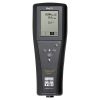Thermo Orion Star A122 Portable Conductivity Meter
Features
- Displays conductivity and TDS readings using Orion 8-pin mini-DIN electrodes
- AUTO-READ function alerts user and locks on-screen readings when stable
- IP67 waterproof rating, 3-year warranty
- Free ground shipping
- Expedited repair and warranty service
- Lifetime technical support
- More
Overview
The Thermo Orion Star A122 portable conductivity meter is waterproof and battery-operated. The Thermo Orion Star A122 stands up to the most demanding field applications and delivers over 2,000 hours of continuous operation. The meter can be calibrated manually or automatically using Thermo conductivity standards to make the setup process easy.
Mechanics
The rugged, user-friendly meter displays conductivity, TDS and temperature readings on a large LCD screen, while icons provide quick updates on battery life, electrode status and calibration information. Simple button layout and on-screen messages simplify calibration and explain setup menu choices.
Benefits
- AUTO-READ function to alert the user and lock on-screen readings when stable
- Selectable cell constant
- Selectable reading reference temperatures of 20 C or 25 C to increase accuracy
- Non-volatile memory holds up to 50 data points
- Electrode arm and newly-designed probe holder to place probes into samples
- Universal power supply or battery power option
- IP67-rated housing (may be immersed for up to one hour with no water incursion)
- 3-year meter warranty
- Conductivity
- Range: 0.1 uS/cm to 200 mS/cm
- Resolution: Min 0.01 uS or 3 significant figures
- Relative Accuracy: 0.5% reading +/-1 digit
- Reference: 20, 25 C (default)
- Compensation: Linear (0.0 to 10.0 %/C)
- Compatible Cell Constants: 0.0001 to 10
- Number of Calibration Points: 1
- TDS
- Range: 1 to 19,999 mg/L
- Resolution: 4 significant figures
- Relative Accuracy: 0.5% reading +/-1 digit
- TDS Factor Range: Linear 0.01 to 10.00, default 0.49
- Temperature
- Range: -5 to 105 C
- Resolution: 0.1
- Relative Accuracy: +/-0.1 C
- Offset Calibration: Yes
- Datalogging
- Number of Points: 50
- Log Function: Manual, Automatic with AUTO-READ
- Log Edit: Delete last reading or all
- General
- Display: Custom LCD
- Inputs: 8-pin mini-DIN
- Power Adapter: Universal AC, 100-240 VAC
- Battery Power: 4 AAs, 2000 hrs life
- Environmental Requirements: 5 to 45 C and 5 to 85% relative humidity, non-condensing
- Regulatory and Safety: CE, TUV 3-1, FCC Class A
- IP Rating: IP67, splashproof and dustproof
- Warranty: 36 months (from date of purchase)
In The News
Choosing The Right Thermo Portable For Your Project
With so many options in Thermo Scientific’s Orion Star A line, it can be difficult to narrow down which meter will best fulfill a project’s needs. One easy way to rule out some meters is by considering application type. For projects that rely largely on collecting samples in the field, a portable meter is clearly the way to go. But there’s still a handful of meters to choose from. To simplify making the right choice, we spoke with Ricki Hartwell, the global product manager for Thermo Scientific’s Orion Laboratory and Field Instruments. She recently shared her tips on choosing the right Thermo benchtop. Let’s take a look at her recommendations for selecting the right portable meter.
Read MoreWhat is Conductivity?
UPDATE : Fondriest Environmental is offering their expertise in conductivity through their new online knowledge base. This resource provides an updated and comprehensive look at conductivity and why it is important to water quality. To learn more, check out: Conductivity, Salinity and TDS. Salinity and conductivity measure the water's ability to conduct electricity, which provides a measure of what is dissolved in water. In the SWMP data, a higher conductivity value indicates that there are more chemicals dissolved in the water. Conductivity measures the water's ability to conduct electricity. It is the opposite of resistance. Pure, distilled water is a poor conductor of electricity.
Read MoreCombating Water Insecurity in Saskatchewan with Real-Time Data
The prairies of Saskatchewan can be described as one of the least water-secure parts of Canada, making water quality monitoring essential for informed resource management in a region already facing water insecurity. While natural physical properties worsen some of the poor water quality conditions in the region, others are connected to land use. Having grown up spending summers on the shores of Lake Huron, Helen Baulch, an associate professor at the School of Environment and Sustainability at the University of Saskatchewan , has always been dedicated to the protection of water resources. Looking back fondly at her childhood playing along the shore, Baulch also recalls the invasion of quagga mussels during her teenage years and watching the lake change as a result.
Read More






















